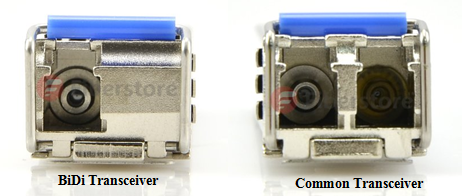Pluggable optical transceivers typically use two fibers to send and receive optical signals between switches, firewalls, servers or routers. One fiber is to receiving data from networking equipment, and the other is to transmit data to the networking equipment. However, a new class of optical transceiver—BiDi transceiver uses only a single fiber to send and receive signals. The reduction in fibers leads to substantial cost-saving especially in high-density applications. Besides that, BiDi transceivers also possess some unique features, which will be illustrated in the following article.
BiDi Transceiver Overview
BiDi is short for Bidirectional. BiDi transceivers use two different wavelengths to achieve transmission in both directions on just one fiber. General optical module has two ports, TX for the launch port, the RX receive port, as seen in the following picture, while BIDI optical module is only one port filtered by the filter in the optical module, which completes the 1310nm optical signal transmitting and 1550nm optical signal receiver, or vice versa. The most frequently used wavelength of BIDI optical module is 1310nm/1550nm, 1310nm/1490nm, 1510nm/1590nm.

Use of WDM (Wavelength Division Multiplexing) technology, BiDi optical transceiver is a compact optical transceiver module used in optical communications for both telecommunication and data bidirectional communication applications. The transceiver interfaces a network device mother board, like a switch, router or similar device, to a fiber optic pairs or unshielded twisted pair networking cable. In the industry there are several synonyms for Bidi optics, like Bi-directional optics, BX-D/BX-U, WDM and so on. Bidi transceivers can be used in different Gigabit Ethernet applications like 1G, 10G or 40G Ethernet.
BiDi SFP Transceiver
BIDI SFP transceiver module is specifically used for the high-performance integrated duplex data link over a single optical fiber. These transceiver modules are compliant with the SFP Multi-source Agreement (MSA). With the hot pluggability, these modules offer an easy way to be installed into SFP MSA compliant ports at any time without the interruption of the host equipment operating online.
BIDI SFP transceiver module using a long wavelength DFB laser diode enables data transmission up to 80km on a single mode optical fiber. BiDi SFP can be produced either with SC or LC simplex port, that is used both transmission and receiving. The transmitter incorporates a highly reliable 1310nm or 1550nm Laser (FP laser for narrow, Intermediate distance and DFB laser for long distance) and a driver circuit which converts data to light with APC function.
QSFP BiDi Transceiver
40G QSFP BiDi transceiver has two 20-Gbqs channels, each transmitted and received simultaneously on two wavelength over a single MMF strand (OM3 or OM4). It allows the existing cabling system including the patch cables, patch panels with MTP/MPO LC modules, and fiber trunks to be repurposed for 40-Gbqs connectivity. In contrast, the common QSFP SR4 transceiver like Cisco QSFP-40G-SR4 requires new patch cables and patch panels because the connector types differ and the size of the fiber trunk needs to be quadrupled.

Cisco recently announced its QSFP 40G BiDi transceiver with duplex LC ports, enabling 100 meters of 40G transmission over OM3, 125 meters over OM4 fiber, and 150 meters over certain OM4+ fibers. QSFP-40G-SR-BD transmits full-duplex 40-Gbps traffic over one dual-fiber LC-connector OM3 or OM4 MMF cable. It provides the capability to reuse 10-Gbps fiber infrastructure. In other words, it enables data center operators to upgrade to 40-Gbps connectivity without making any changes to the previous 10-Gbps fiber cable plant.
How BiDi Transceivers Work
The most obvious difference between BiDi transceivers and traditional transceivers is that BiDi transceivers are fitted with WDM couplers, which combine and separate data transmitted over a single fiber based on the wavelengths of the light. The figure below depicts the details of how BiDi transceivers work. The two wavelengths that have been used in this example are 1310nm and 1490nm. Usually the upstream transmits at the shorter wavelength, while the downstream the longer wavelength.

Note that BiDi transceivers must be deployed in pairs, with their diplexers tuned to match the expected wavelength of the transmitter and receiver that they will be transmitting data from or to.
FS.COM BiDi Transceiver
The value of the BiDi solution derives from the reduction in the use of fiber, which makes BiDi transceiver an ideal solution in any situation where only limited fibers or limited conduit space is available. FS.COM offers a 1Gbps SFP BiDi transceivers to cover a wide range of distances including: 10km, 20km, 40km, 80km, 120km and 150km, all of which are ROHS compliant. And our 10Gbps BiDi transceivers are available supporting reaches of 20km, 40km and 60km. Even for the 40G BiDi transceiver, we offer compatible Cisco QSFP-40G-SR-BD for future proofing.
评论
发表评论